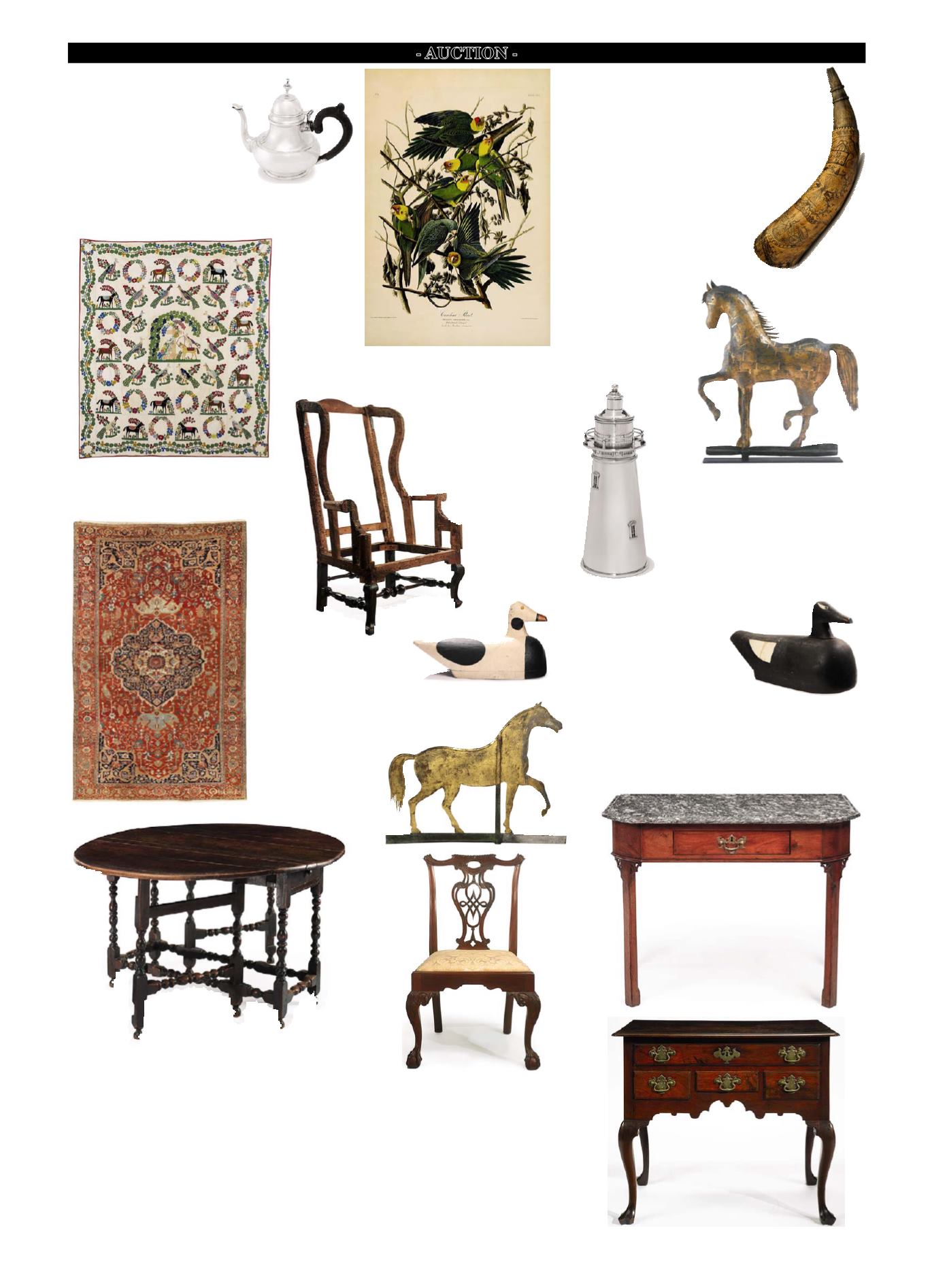

Maine Antique Digest, April 2015 13-B
- AUCTION -
Gilded sheet iron horse weathervane, signed
William F. Tuckerman, Boston, Massachu-
setts, circa 1860, the maker’s mark stamped
on the head, 23" high x 30" long, $34,375 (est.
$7500/10,000) to a phone bidder.
The Captain John Graham Revolutionary War powder
horn with a map engraved by Harmon Stebens, New York,
1779, 17" long, sold for $62,500 (est. $40,000/60,000) to
a phone bidder. It is engraved with a map of the Hudson
and Mohawk Rivers showing the location of various towns
and forts, plus a figure of a mermaid and a lion and vari-
ous views of buildings and towns. Inscribed on the horn are
“1779 / John / Graham / Captn,” “Unighted We Stand ·
Devided We fall,” and “Honours of Warr”; inscribed on
the plug is “Harmon Stebens.” John Graham (1756-
1832) was a founding member of the Society of the
Cincinnati.
The horn is in excellent overall condition—
Sotheby’s said it has “a rich golden hue”—
and it has one of the first depictions of the
13-star American flag. There is a market
for the best in any category. When this
horn sold at Christie’s in January 2003,
it brought $13,145.
Carolina Parrot
(Plate XXVI)
by R. Havell
after
John
James Audu-
bon,
1828,
hand-colored
e n g r a v i n g ,
etching,
and
aquatint
on
wove
paper
with a J. Whatman Turkey Mill 1833 watermark, sheet
size 38" x 25 3/8", $46,875 (est. $50,000/70,000).
Rare William and Mary
turned and joined maple easy
chair, Boston, $12,500 (est.
$10,000/20,000) to a phone
bidder. Although this easy
chair had lost a portion of
its legs, it is a rare survivor;
only ten with square
cabriole legs exist.
Robert
Trent
discussed it at
length in his
article
“Bos-
ton
Baroque
Easy
Chairs,
1705-1740” in
American Fur-
n i t u r e 2012
.
Heriz carpet, north-
west Persia, circa 1900,
approximately
23'2"
x 14'4", $22,500 (est.
$15,000/20,000). Of the
19 carpets offered, this
was the most expensive of
the 13 that sold; the least
expensive was a 14'10" x
10'5" Heriz that brought
$5000.
This very rare figured mahogany mar-
ble-top slab table with a drawer, prob-
ably made in Virginia, circa 1780, sold
for $62,500 (est. $50,000/80,000) on
one bid against its reserve. Although it
appears to retain its original King of
Prussia, Pennsylvania, marble top, its
construction differs from Philadelphia
marble-top tables, as does the incor-
poration of a drawer. King of Prussia
marble was shipped throughout the
Colonies.
This American silver pyriform teapot by Jacob
Gerritse Lansing (I), Albany, New York,
circa 1730, with a chased mid-
band, faceted spout, high domed
cover with baluster finial, the base
engraved with initials “I / GLS” and
either side of the handle marked
“IGL” in a rectangle, 7 3/8" high, was
fresh to the market. It had descended
in successive generations of the Lansing
family and was offered together with a
copy of the exhibition catalog
Albany Silver
1652-1825
(1964) and accompanying papers. A collector
on the phone won it at $46,875 (est. $30,000/50,000).
Pieced and appliquéd cotton bedcover, pos-
sibly Baltimore, circa 1850, with an Elliott
and Grace Snyder provenance, $10,000 (est.
$8000/12,000) to a phone bidder.
Molded and gilded copper
horse weathervane, A.L.
Jewell & Co., Waltham, Mas-
sachusetts, circa 1860, 30"
x 27", with a Sy and Susan Rap-
paport provenance, $40,625 (est.
$35,000/40,000).
Mahogany side chair, Philadelphia,
circa 1770, 37¼" high, the slip seat
marked IIII, the chair marked V,
$22,500 (est. $15,000/25,000) to an
on-line bidder, underbid by Penn-
sylvania advisor Alan Miller in the
room. The splat design was inspired
by Ince and Mayhew’s
The Univer-
sal System of Household Furniture
(1762). It is similar to a chair in the
Mabel Brady Garvan Collection at
Yale. At least five variants of this
design are known. The carving sets
this chair apart.
Queen Anne figured walnut dress-
ing table with an old surface and
original cast brass hardware, Phil-
adelphia, circa 1760, 29" x 34"
x 21", $13,750 (est. $5000/8000)
to Quakertown, Pennsylvania,
advisor Alan Miller in the room,
underbid on line.
American silver-plated cocktail shaker in
the form of a lighthouse with windows,
International Silver Company, marked on
base, numbered 343, and stamped “Pat-
ented Jan. 11 1927,” 13 5/8" high, $25,000
(est. $10,000/15,000). At Christie’s the day
before, a 13½" high Meriden Silver Plate
Company lighthouse-form cocktail shaker
sold for $3750. In March 2012 Christie’s
sold a 20½" version for $11,875.
Hollow-carved surf scoter decoy (right),
probably Scituate, Massachusetts, early
20th century, and hollow-carved eider
decoy (left) by the same hand, each
15" long, each decorated with black
and white abstract patterns, $10,000
each to the same phone bidder. They are
similar to examples in the published col-
lection of Susan and Jerry Lauren of New
York City.
The Abigail Wiswell Jones William and Mary turned walnut gate-
leg dining table, Boston, Massachusetts, circa 1720, appears to retain
an old, and probably original, finish. The top had been decreased in
size; the table is 18¼" high x 18" wide (closed) and 54" wide (open)
x 47" deep. It sold without reserve for $3750 (est. $20,000/30,000)
to the same phone bidder who bought the William and Mary easy
chair, underbid on line. At Sotheby’s in October 2000, it sold for
$115,000 (est. $100,000/150,000) to dealer Leigh Keno.
According to the catalog, “This table was likely present at the
Sewall house—then home of Madame Jones—in the early hours
of April 19, 1775, when Paul Revere, John Hancock, John Adams,
and John Lowell gathered after the prior evening’s historical ‘Mid-
night Ride.’ It was in this setting that they regrouped, and prepared
for the events which inevitably lead to the Battle of Concord and
the ‘shot heard ‘round the world.’” It was a bargain for a piece of
history.










